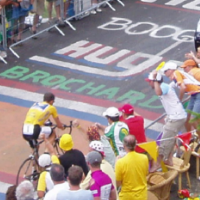Moritz asked an excellent question in the comments of the recent Lactate Threshold Field Test
Any reason you suggest a 20 minute flat-road hard effort rather than a fast-hill effort as in your last year’s article? I’d like to understand (and be able to explain) the differences and possible reasons one vs. the other method.
I’ve learned a lot in the past year. I’ve been reading a lot about field testing, cadence, muscle fibers, fatigue, etc. I’m always trying to learn more, for my own knowledge and good, but also so I can better answer your questions. First, let’s talk about cadence in general and then I’ll dive into the physiology of difference pedaling speeds.
One thing that comes up again and again in cycling coaching is that the higher the cadence (to a point) the less resistance per pedal stroke, the less fatigue on the muscle fibers, and the less fatigue on the legs. Your legs will fatigue before your cardiovascular system. For years, especially since the heyday of Lance Armstrong and his famous higher cadence than most of his contemporaries, many coaches have been encouraging cyclists to pedal faster on flat roads, in the 90–100 rpm range. More and more cycling coaches suggest learning to climb at higher cadences, some of them even suggesting that one shouldn’t pedal slower than 70 or even 80 rpm on a climb. I know where I live in the Rocky Mountains, in my lowest gear (a compact gearing) that wouldn’t be even possible (for me, that is)!
If you’re going to climb Alpe d’Huez in France, or Independence Pass in Colorado, then yes, the faster cadence will save your legs over the long run. But in a 45- to 60-minute indoor class, we can certainly allow our students to pedal as slow as 60 rpm, occasionally going as slow as 55 rpm in short periods for those skilled riders who have been preparing for the stress.
Coach Levi, an online cycling coach, describes the following ranges of cadences in his article High Cadence vs. Low Cadence Cycling
Cadence varies between riders and even the same rider will vary their cadence in a given situation, but most elite riders use a fast cadence. There is no “one size fits all” perfect cadence, but we’ll look at the differences between the high and low cadences in this article.
For the purposes of this article, I will use the following measurements to describe cadence:
- Very slow: 50–70 RPM
- Slow: 70–80 RPM
- Moderate: 80–90 RPM
- Fast: 90–100 RPM
- Very Fast: 100–110 RPM
- Extremely Fast: 110+ RPM
To simplify even further, you can consider anything under 90 RPM to be a low cadence, and 90+ RPM would be a high cadence.
That’s quite different than how we usually describe cadence indoors, isn’t it? Anything under 90 rpm is considered low cadence? Try telling that to the big guy turning the pedals at 45 rpm to “train the strength” in his legs. I think of anything over 100 rpm as very fast, and rarely if ever go above 110 rpm, but as we all know, in so many classes around the world, 120–140 with no resistance is the norm, and 100 would seem “slow.” Those riders aren’t seeing many results from their “Spinning” classes because they aren’t engaging very many muscle fibers with such low (or no) resistance. Yet their heart rates are high.
So, now it’s time to lead this discussion to answer Moritz’s question on field testing and cadences. Let’s talk about the physiology of pedaling at various cadences.


Hi Jennifer. Just coming back to ICA after a while away. I really appreciate all of your efforts to raise the bar for indoor cycling. I realize this post came several months ago, so sorry for the late comment!
Re: Optimal cadence for field testing… I’m a big believer in the concept of “self-selected” cadence – the idea that most riders have a cadence range that is most metabolically efficient for them.
For that reason, I tend not to prescribe a specific cadence range for field testing, but instruct riders to select a cadence that feels right for them – i.e., they are able maintain steady power ouptput (we have power-enabled bikes) while maintaining a smooth pedal stroke (feeling pedal engagement throughout and avoiding “mashing”). For most riders, this seems to fall somewhere in the 85-95 rpm range, but may be slightly lower or slightly higher for some. So, it really tends to be about the same range you’re discussing here.
Here’s a nice review article discussing “optimal” cancence for cycling: http://bit.ly/hN0L5Q
From the conclusion of the article:
“Based on previous research, it would appear that muscle force and neuromuscular fatigue might be reduced, and cycling power output maximised, with relatively high pedal rates (100-120rpm). However, such high pedal rates increase the metabolic cost of cycling, especially at low power outputs… Due to the influence that fast pedal rates have been shown to impart on cycling mechanics, cycling efficiency and fatigue development, performance in longer duration events might be enhanced from use of slightly slower cadences (~90-100rpm). During ultra-endurance cycling, performance might be improved by using relatively low cadences (70-90rpm), since cycling economy is improved and energy demands are lowered.”